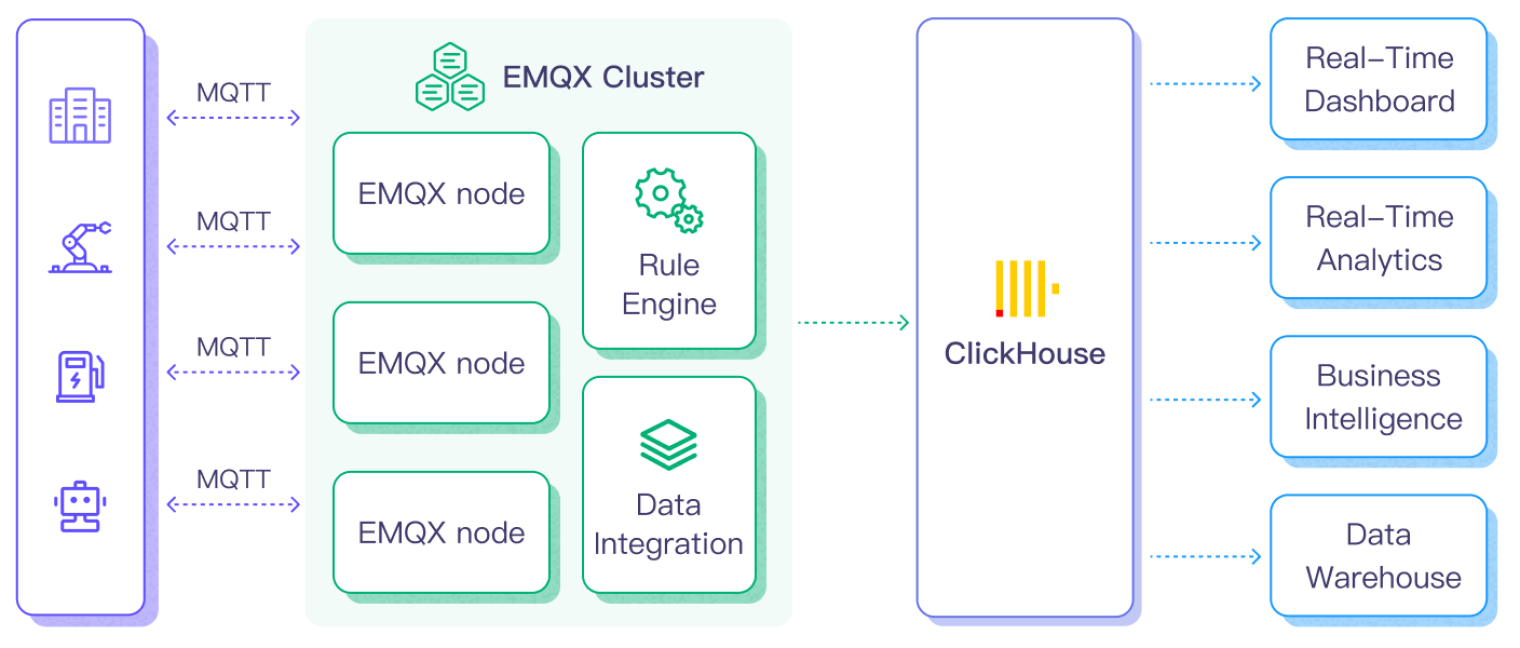Introduction
In today's fast-paced world, the ability to capture and process real-time data is essential for businesses to optimize operations and make informed decisions. This is where the powerful combination of MQTT (Message Queuing Telemetry Transport) integration with ClickHouse, an open-source columnar database management system, comes into play.
In this blog post, we will explore how MQTT integration with ClickHouse can unleash the power of data analysis and drive enhanced performance across these diverse industries.
Understanding MQTT and ClickHouse
The MQTT protocol, specifically designed for IoT applications, enables efficient and reliable communication between devices. It employs a lightweight publish-subscribe model, ensuring seamless data transmission even in resource-constrained environments. MQTT's low overhead and support for real-time data streaming make it an ideal choice for capturing and transmitting IoT data from various endpoints to data processing platforms.
ClickHouse, a high-performance, column-oriented SQL database management system (DBMS) for online analytical processing (OLAP), excels in processing and analyzing large volumes of data with minimal latency. Its columnar storage format and parallel query execution optimize data retrieval and aggregation, enabling lightning-fast analytical capabilities. ClickHouse is renowned for its scalability, allowing organizations to handle the ever-growing data volume generated by IoT devices while maintaining exceptional performance.
Benefits of MQTT Integration with ClickHouse
With MQTT as the communication layer, data from IoT devices can be easily transferred to ClickHouse, and get efficiently stored and processed with its high-performance analytical capabilities.
EMQX is the most popular MQTT broker. Its out-of-box data integration capabilities can seamlessly enable an MQTT-ClickHouse solution and bring several benefits:
Real-time Data Streaming: EMQX is built for handling real-time data streams, ensuring efficient and reliable data transmission from source systems to ClickHouse. It enables organizations to capture and analyze data in real-time, making it ideal for use cases requiring immediate insights and actions.
High Performance and Scalability: EMQX's distributed architecture and ClickHouse's columnar storage format enable seamless scalability as data volumes increase. This ensures consistent performance and responsiveness, even with large datasets.
Flexibility in Data Transformation: EMQX provides a powerful SQL-based Rule Engine, allowing organizations to pre-process data before storing it in ClickHouse. It supports various data transformation mechanisms, such as filtering, routing, aggregation, and enrichment, enabling organizations to shape the data according to their needs.
Easy Deployment and Management: EMQX provides a user-friendly interface for configuring data sources, pre-processing data rules, and ClickHouse storage settings. This simplifies the setup and ongoing management of the data integration process.
Advanced Analytics: ClickHouse's powerful SQL-based query language and support for complex analytical functions empower users to gain valuable insights from IoT data, enabling predictive analytics, anomaly detection, and more.

By leveraging the EMQX data integration with the ClickHouse, organizations can streamline their data integration workflows, capture real-time data, ensure data security, and efficiently store and analyze it in ClickHouse. This made a powerful tool for those looking to harness the full potential of their data and drive data-driven insights and decision-making.
Use Cases in Various Industries
Industrial IoT and Predictive Maintenance: MQTT to ClickHouse integration enables real-time monitoring and analysis of data from machines, sensors, and production lines. Organizations can detect anomalies and patterns that indicate equipment failure or maintenance needs by collecting and analyzing data such as temperature, vibration, and operating conditions. This allows for proactive maintenance, reduced downtime, and optimized production processes.
Environmental Monitoring: MQTT to ClickHouse integration enables real-time data collection and analysis from environmental sensors, weather stations, and air quality monitoring devices. This use case finds agriculture, forestry, pollution control, and climate monitoring applications. Organizations can leverage the data to make informed decisions about irrigation, crop health, resource management, and environmental conservation.
Energy Management and Grid Optimization: MQTT to ClickHouse integration facilitates real-time monitoring and analysis of energy consumption data from smart meters, renewable energy sources, and grid infrastructure. This allows for effective energy management, load balancing, demand response, and integration of renewable energy resources into the grid.
Logistics and Supply Chain Optimization: MQTT to ClickHouse integration can be applied in logistics and supply chain management to monitor and analyze data from IoT devices such as GPS trackers, temperature sensors, and inventory management systems. This enables real-time tracking, route optimization, demand forecasting, and efficient inventory management, leading to streamlined operations and cost savings.
Conclusion
The versatility and real-time capabilities of MQTT, combined with ClickHouse's data storage and analytics power, enable various industries to leverage IoT data for enhanced operational efficiency, cost savings, and data-driven decision-making. With the Data Integration capabilities of EMQX, organizations can benefit from a reliable, scalable, and feature-rich MQTT broker and easily achieve this powerful combination.
